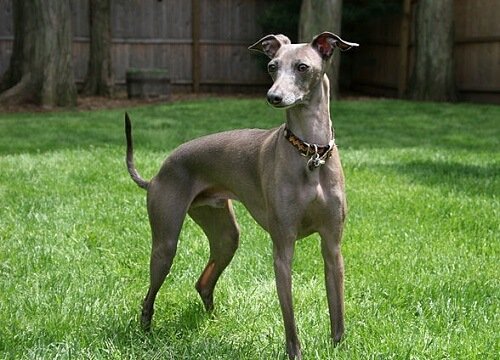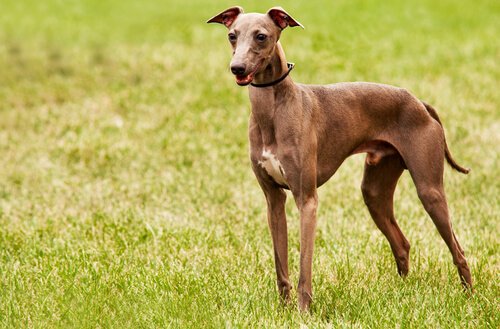The Italian Greyhound: Small and Affectionate
4 minutes

The Italian Greyhound is the smallest breed of all the greyhound breeds. However, despite weighing only five kilos, it’s not less valuable than other breeds. Also, the breed can reach incredible speeds for its size. So, continue reading to find out about this funny but wonderful greyhound breed:
Origin of the Italian Greyhound
Like many hound and podenco breeds, the Italian Greyhound (also known as the Small Italian Greyhound) has an ancestral origin. People believe they are descendants of dogs that lived with ancient Egyptians.
As for the Italian Greyhound’s, skeletal remains have been found in Greek excavations that shows these dogs lived with humans in 3000 BC. No one knows how they came to the Italian peninsula, but people believe that it was soon after. This means this breed is one of the oldest known dog breeds.
During the Renaissance, people used them to hunt rabbits and other small animals. They were highly-valued dogs. In fact, you can see many dogs of this breed in portraits of nobility.
Currently, the Italian Greyhound is a companion dog and is no longer used for hunting, unlike many other breeds of greyhounds. This breed’s affectionate personality and small size have made them a great dog for the home.

Physical traits
This greyhound breed closely resembles its hound relatives physically, but it much smaller.
Adult specimens usually measure between 32 and 38 cm in height, and weigh only four or five kilos. Males and females don’t really differ in size or weight.
In addition, its limbs are long for its body, but they are proportionate for its size. Its legs are long and thin, but its body tends to have the same length as its height. In other words, this breed has a square, balanced appearance, which gives them an elegant, fragile, and agile look.
Its head is also long and thin, with a snout that gets narrower at the tip and has a darker-colored nose that’s larger than the noses of other small-sized dogs.
Its ears are triangular, wide and large. They are placed high up on its head, folded over themselves and extend towards its nape.
Unlike other greyhound breeds, this Italian breed has straight shoulders instead of arched ones. Also, their tail is thin and long, and wider at the base.
On the other hand, the Italian greyhound’s fur is shiny and fine. Also, it only has one smooth tone with no stripes. This breed’s fur can be white, cinnamon, grey or yellow, and it may have white spots on its chest and feet.
Personality
The Italian Greyhound is an extremely affectionate dog who always wants to be around family because he wants them to give him the attention he deserves. These dogs are extremely intelligent, and have a great desire to please others. They are always ready to learn new things.
However, this breed is sensitive and gets easily stressed. They love to live in a quiet house, with predictable humans who don’t play with their emotions. So, these dogs will be happier living with senior citizens or quiet people, than in a house with children.
On the other hand, this breed is shy but affectionate at the same time. Plus, this dog is agile but not energetic. You can take care of this dog’s exercise needs with three quality walks per day. So you don’t need to give it more exercise than those walks, or play stressful games.
They can also be shy or suspicious around strangers. This combines with the fact that they are timid and afraid of unknown situations because they are small dogs.
Veterinary care
The Italian greyhound is a relatively healthy breed, so they don’t usually have any hereditary diseases. Therefore, this breed only needs the recommended veterinarian checkups, although you can’t neglect to keep its vaccines and deworming up-to-date.
Because they are small dogs, with thin, fragile bones, you must be careful around them because they usually get too close to their owners. So, be careful not to step on them and seriously harm them. They are fragile dogs, both psychologically and physically.
Since they are so thin and sensitive, they adapt poorly to low temperatures. So, you should keep them warm on cold days. Likewise, you should also give them a warm and comfortable place to pass the winter, and thus reduce the risk of getting sick from the cold.
Finally, since this dog’s job was chasing small animals, don’t play games that involve chasing small objects, because it be stressful for them. Instead, they are better off receiving affection from their human families.